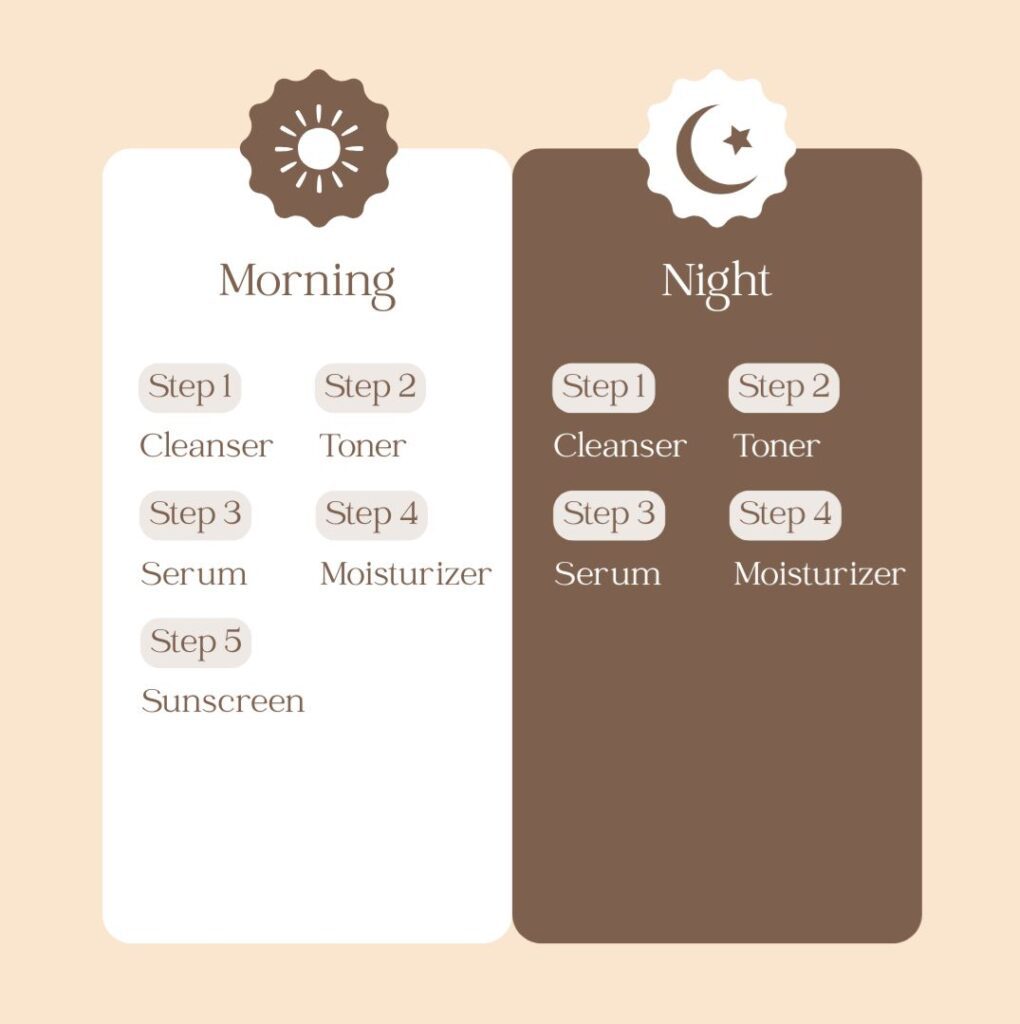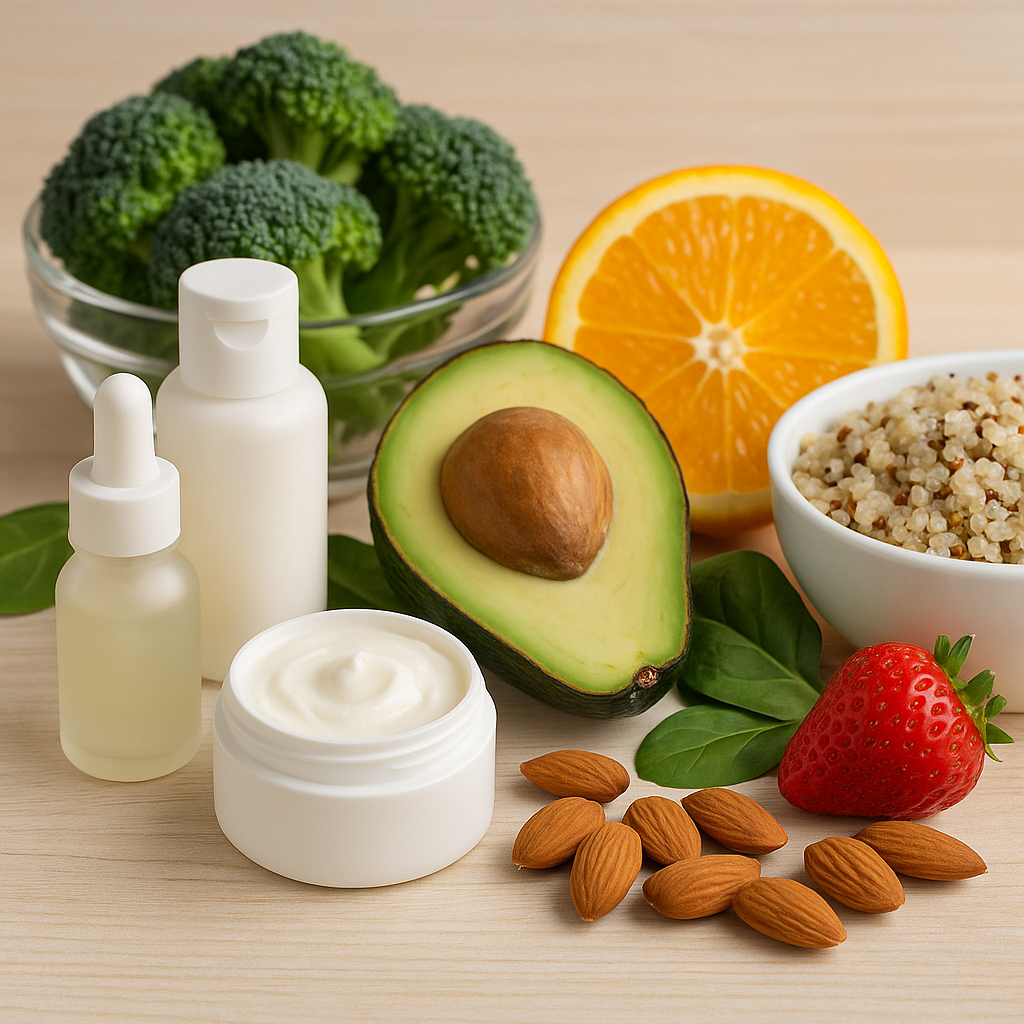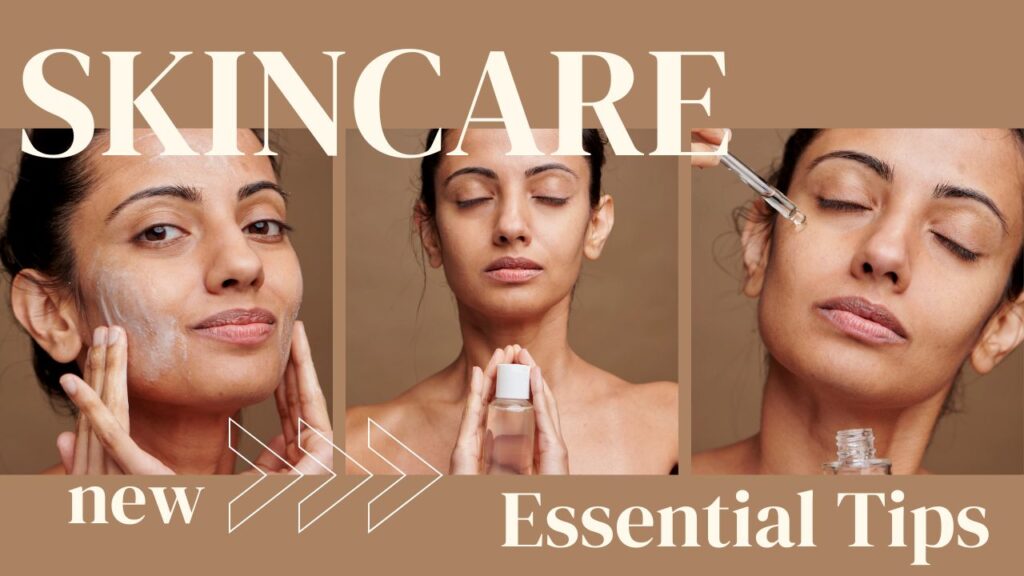The key towards having an essential skincare routine order is not only to have good products but also knowing how to use them, with the right sequence. By putting on your skincare products in the right order, this will make sure that every single product can get in and work its magic. Completely wrong and you might as well be putting your money to waste in wasteful product use.
Thus, when you have been in this situation where you stare at your bathroom mirror thinking of what to do first, you are not alone, and you are in the right page. These are all the steps you should follow in order to achieve an optimal skin care routine (both morning and night) step by step.
A Golden rule of Skincare, Thinnest to Thickest rule
Placing the thinnest layers of skin care product on the skin, followed by increasingly thick layers. The thumb rule of skin care regime is to apply the liquid to thick layer products. This gives the lighter water based products the opportunity to absorb without getting blocked by the oil-based heavier ones. It plays a very important role in maximizing product effectiveness.
Morning Skincare Routine: Sun protection and preparation to the day
The morning routine is about cleansing, preserving the intact condition of the skin against the interaction of the environment and getting it ready to the nearest day. Just imagine that you wear the armor on your skin.
Step 1: Cleanser Your Fresh Start
- Why it is necessary: Even when you washed off the previous night your skin secretes the oil and dead skin cells during the night. These impurities are cleaned out in a gentle way, and your skin is ready to absorb the products.
- Application method: Mild pH balanced cleanser is to be used. Wet your face with tepid water, coat a small amount of cleanser, spread it on your face, and repeat the movement applying soft circular motions, and rinse. Wipe with a dry towel.
Step 2: Toner Balancing Act (Optional, and Advised)
- Why it is good: Toners help to restore the pH of your skin after cleansing, get rid of the remaining impurities and give an instant infusion of miniaturization, which will make the next products more assimilated.
- Application: Applied as a couple of drops on a cotton pad and swiped across the face or pour out small amount on your palms and pat onto the face.
Step 3: Serum Targeted Treatment
- ·Why it’s crucial: Serums are treatments with a high concentration that are made to bring powerful ingredients directly to your skin. In the morning, an antioxidant serum like Vitamin C is definitely the best choice to be safe from the damage caused by free radicals that come from UV and pollution.
- How to apply: Put 2-3 drops on your fingertips and then softly press or tap your face and neck. Allow it to absorb fully for one or two minutes.
Step 4: Eye Cream Delicate Care
- Why it’s important: Skin around eyes is very thin so it is easily damaged by dryness, wrinkles and puffiness. Eye creams are made especially for this sensitive part of the face.
- How to apply: Use your ring finger (the weakest finger to avoid pulling) to take a pea-sized amount and apply it around your orbital bone, gently patting until it is absorbed. Do not pulling or rubbing.
Step 5: Moisturizer Hydration Lock
- Why it’s necessary: The moisturizer for oily skin is a must! It has a double effect of hydration and skin protection plus it cools and softens for the whole day.
- •How to apply: Using your fingertips, rub a small amount (dime sized) on your face and neck in an upward direction.
Step 6: Sunscreen Your Daily Shield (Non-Negotiable!)
- •Why it is most vital step: It is the most important step in your morning routine. Sunscreen shields your skin from the rays of UVA and UVB that are very harmful, thus it prevents the occurrence of premature ageing, freckles and it is very effective in decreasing the possibility of getting skin cancer.
- How to apply: As the very last step apply liberally (about the size of a nickel for your face and neck). Choose SPF 30 or more and remember to reapply every two hours if you are outside or if you sweat.

Your Evening Skincare Routine: While You Rest, Repair and Renew
The main aim of your evening routine is to get rid of the dirt accumulated during the day, to provide the skin with moisture, and to assist the skin’s regeneration process at night, which is the time when the skin is most effective.
Step 1: First Cleanse Breaking Down Dirt (If Wearing Makeup/SPF)
- Why it’s essential: This “first cleanse” (most probably with oil cleanser or water) is the key to efficiently makeup, sunscreen, and the sebum that is produced excessively removal without your skin being stripped apart. Oil is attracted to oil, which makes it very efficient in dissolving the impurities.
- How to apply: Using dry hands apply it to dry skin, massage lightly and then add a bit of water to emulsify before rinsing. If water is your choice, take a cotton pad saturated with it and gently wipe your face.
Step 2: Second Cleanse Deep Purification
- Why it’s important: The second cleanse with a water based cleanser after the first cleanse has gotten rid of surface impurities will help the skin be clean in depth area and take care of the dirt that might be there from the sweat or the residues.
- How to apply: Do the same as you have done for your morning cleanse.
Step 3: Toner Rebalancing Act
- Why it’s beneficial: It also balances the pH and prepare your skin for the next treatment products.
- How to apply: Just like in the morning.
Step 4: Treatment Targeted Concern Addressing
- Why it’s important: This is the part of your skin care routine that is aimed at fixing the problems that are with your skin. Nighttime is the most suitable time for using the strongest actives like Retinoids (anti-aging, acne, texture) or exfoliating acids (AHAs/BHAs that not only exfoliate but also brighten). If you use spot treatment, then it should be done at this step.
- How to apply: Take the size of the treatment that you have figured out is suitable to you. If you are new with retinoid or acids, go slow (2-3 times a week) and then gradually increase the frequency as your skin becomes more tolerant. Always remember product instructions are the most important and use exfoliants 1-3 times per week depending on the skin type.
Step 5: Serum Replenish and Nourish
- Why it’s important: A hydrating or restorative serum after your procedure can rehydrate the skin and additionally meet certain needs such as providing barrier support or being anti aging , if this is the case then your targeted treatment can be complemented.
- ·How to apply: Place 2-3 drops on your fingertips and lightly press or tap the skin of your face and neck. Please note some products ( like vitamin C and retinoids) need time to absorb for applying the next step.
Step 6: Eye Cream Overnight Repair
- Why it’s necessary: At night, the skin of the eyes receives the hydration and targeted treatment besides the fact that it is the area that receives the least treatment at night, the skin alleviates the night process of the repair naturally.
- How to apply: Follow the same procedure as in the morning.
Step 7: Night Cream/Heavier Moisturizer Ultimate Hydration
- Why it’s vital: Mostly, night creams are more rich and occlusive than day creams; they are perfect for providing a lot of moisture and also supporting the process of skin repair during sleep, thus being able to save all the benefits.
- How to apply: A few drops (2-3) of the oil warm up in your palms and then softly press it into your face and neck.
The Inside Out Approach: The Role of Food and Water Intake in Skincare
Certainly, topical creams are essential but nutrition is the only way to get perfectly healthy and radiant skin. The impact of what you take to your skin is so deep that it changes the condition, look, and even the skin’s resistance.
The Power of Hydration: Water is Your Skin’s Best Friend
Essentially: Skin is about 75% water. Drinking enough water is very important for skin health because it can help the skin to be more hydrated, elastic, and of a nice color. A dehydrated person’s skin will appear dull, tight and the wrinkles will become more obvious.
How it helps:
- Maintains Elasticity: Water supports your skin in keeping its elasticity, thus it will be less likely that you develop sagging and wrinkles.
- Flushes Toxins: It helps your body get rid of waste and toxins, and this can be a good cause of the reduction of acne and other problems of skin.
- Supports Barrier Function: The skin remains sufficiently hydrated barrier will be stronger and more efficient in protecting against environmental aggressors and keeping water loss at a minimum.
- Regulates Oil Production: A lack of water in the skin sometimes can make it produce more oil than needed, hence leading to breakouts. Proper hydration helps balance oil levels.
Recommendation: A good start is to have eight 8-ounce glasses of water a day. People are unique in their water needs that depend on the physical activity, temperature, and health condition, so it is important to be attentive to your body. The act of carrying the reusable water bottle becomes like a small reminder that you are supposed to drink water regularly.
Nourishing Your Skin: The Role of a Balanced Diet
Why it’s important: The building blocks, vitamins, minerals, and antioxidants that are present in your food are going to give your skin just the right amount of nutrients it needs for the best-working, fixing up, and fighting against damage.

Key nutrients and their benefits
1. Antioxidants(30–35% of skin-supportive diet)
Role in skin health
Antioxidants are compounds that protect the skin from oxidative damage caused by free radicals unstable molecules triggered by pollution, UV exposure, and internal stress. These free radicals can speed up aging, dullness, and uneven skin tone.
Top sources
-
Berries (blueberries, strawberries, raspberries)
-
Leafy greens (spinach, kale)
-
Bell peppers (red, yellow)
-
Citrus fruits (oranges, lemons)
Benefit
They reduce inflammation, prevent premature aging, and support a bright, youthful complexion.
2. Omega-3 Fatty Acids (~15–20%)
Role in skin health
Omega-3s are essential fats that help maintain the skin’s lipid barrier crucial for keeping moisture in and irritants out. They also have powerful anti-inflammatory properties that calm the skin.
Top sources
-
Fatty fish (salmon, sardines, mackerel)
-
Flaxseeds and chia seeds
-
Walnuts
Benefit
Improves skin hydration, reduces redness, and helps manage inflammatory conditions like acne, psoriasis, and eczema.
3. Vitamin C (~10–15%)
Role in skin health
Vitamin C is a water soluble antioxidant necessary for the synthesis of collagen a protein that maintains skin structure and firmness. It also enhances skin protection against sun damage and pollution.
Top sources
-
Citrus fruits (oranges, lemons)
-
Kiwi
-
Broccoli
-
Strawberries
Benefit
Boosts collagen production, brightens the skin, reduces hyperpigmentation, and protects against UV damage.
4. Vitamin E (~10–12%)
Role in skin health
Vitamin E is a fat-soluble antioxidant that defends skin cells against oxidative stress. It also enhances skin smoothness and supports healing of damaged skin.
Top sources
-
Sunflower seeds
-
Almonds
-
Avocados
-
Hazelnuts
Benefit
Protects skin cells from damage, improves texture, and supports repair and moisture retention.
5. Zinc (~5–8%)
Role in skin health
Zinc plays a vital role in wound healing, reducing inflammation, and regulating oil production. It is especially effective in the management of acne.
Top sources
-
Pumpkin seeds
-
Chickpeas and lentils
-
Lean beef and poultry
-
Cashews
Benefit
Helps with acne treatment, supports tissue repair, and strengthens the skin’s immune function.
6. Protein (~15–20%)
Role in skin health
Protein provides amino acids that are essential for the production of collagen and elastin two key proteins responsible for skin strength and elasticity.
Top sources
-
Chicken and turkey
-
Fish
-
Eggs
-
Lentils and beans
-
Quinoa
Benefit
Strengthens skin structure, promotes elasticity, and accelerates skin regeneration and repair.
Foods to limit
- High glycemic foods (refined sugars, processed carbs): Such foods may cause overproduction of oil by the sebaceous glands hence leading to acne and inflammation.
- Excessive dairy (for some individuals): Due to the presence of hormones, it is possible that in some cases this will be the trigger for the acne to come out.
- Trans fats and excessive alcohol: These could result in skin inflammation that may consequently become the aggressive factor of the aging process and be a reason for skin dehydration.
Skincare is needed for all skin types period
The misconception that only the specific skin types are in need of the skincare routine is going around in the community. The fact is that though the skin is only healthy if it is deeply and consistently cared for, the skin type does not matter whether it is oily, dry, combination, sensitive, or “normal.”

The following reasons require us to care for our skin no matter what skin type we have:
- The Protection From Environmental Damage: Our skins are the main targets of the most harmful factors such as UV radiation from the sun, pollution, and free radicals. Cleansing removes pollutants, serums with antioxidants neutralize the damage, and sunscreen is obligatory for everyone irrespective of your skin color if you want to prevent early aging and skin cancer.
- Maintaining Skin Barrier Health: The skin barrier is the main defense mechanism of your body against the irritants, bacteria, and moisture loss sources. Skin care routine makes this defense barrier stronger and thus it stays such through gentle cleansing, hydration, and moisturizing. No matter how oily your skin is, this is the best method.
- Addressing Specific Concerns: Some of the most common skin problems are acne, hyperpigmentation, fine lines, and redness. Having a targeted skincare routine means you can not only add the ingredients that are most suitable to your problem, but you can also make sure that the process of the solution is continued to be improved.
- Promoting Overall Health and Well-being: Usually, good skin is the result of good internal health. In addition, the very fact of doing a skincare routine can be seen as a moment of self care and relaxation.
Preventing Issues
- Oily Skin: Requires cleansing to get rid of the excessive sebum and avoid clogged pores, and lightweight hydration to maintain oil production in the balance.
- Dry Skin: Demands uninterrupted hydration in order not to lose moisture besides, it also prevents the skin from getting flaky, and tight.
- Sensitive Skin: Demands products that are simple and do not contain a scent, thus it will be easier for the skin to not have a reaction and consequently, it will be cooled, shielded, and irritation will be avoided.
- Normal Skin: Gets good from keeping its healthy balance, solving the future problems and being protected from the aging process.
- Supporting Skin Functions: The skin is a living organ that is constantly renewing itself. The routine is means of this process as it helps the skin to get rid of dead cells (cleaning, exfoliation), to be nourished (serums, moisturizers), and also to be repaired (night treatments).
- Addressing Specific Concerns: Some of the most common skin problems are acne, hyperpigmentation, fine lines, and redness. Having a targeted skincare routine means you can not only add the ingredients that are most suitable to your problem, but you can also make sure that the process of the solution is continued to be improved.
- Promoting Overall Health and Well-being: Usually, good skin is the result of good internal health. In addition, the very fact of doing a skincare routine can be seen as a moment of self care and relaxation.
General Skincare Tips for Optimal Results
- Listen to Your Skin: Your skin is unique. Adjust the products and routines according to the condition of your skin and its response. If the product makes you burning sensation or irritates, stop using it immediately.
- Consistency is Key: A skincare routine will not give you results that are apparent from the beginning. Continue your routine regularly for at least 4-6 weeks to see changes. Patience is a virtue in skincare!
- Patch Test New Products: It is a very good idea to do a test of a new product on a small, less visible part of your skin (behind your ear or on your inner arm) before you apply it on the whole face, if you have sensitive skin or you have had allergic reactions in the past.
- Don’t Overdo It: The use of many active ingredients at the same time, more than is necessary, can cause skin irritation and damage to the skin barrier.30 Introduce new products one at a time and space out the powerful treatments.
- Maintain Cleanliness: Be sure that you apply skincare products with clean hands. Frequently change your pillowcase to prevent bacterial growth that can lead to skin disruption.
Conclusion
Understanding and following the correct order of skincare steps is essential for getting the most out of your products and achieving healthy, glowing skin. From cleansing to moisturizing and applying treatments like serums, exfoliants, and sunscreen in between each step builds on the last to deliver maximum results. When done consistently and in the right order, your skincare routine not only enhances your skin’s appearance but also strengthens its barrier, balances oil production, and protects it from environmental stressors. No matter your skin type, sticking to a simple, well structured routine is the foundation for long term skin health.

 Medically reviewed by
Medically reviewed by